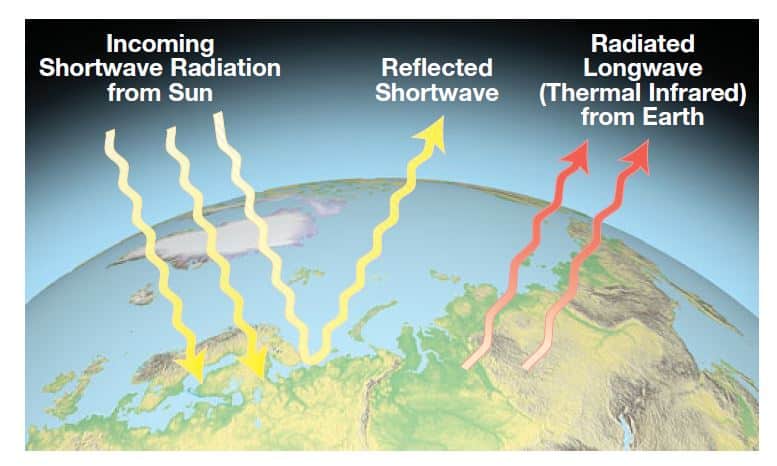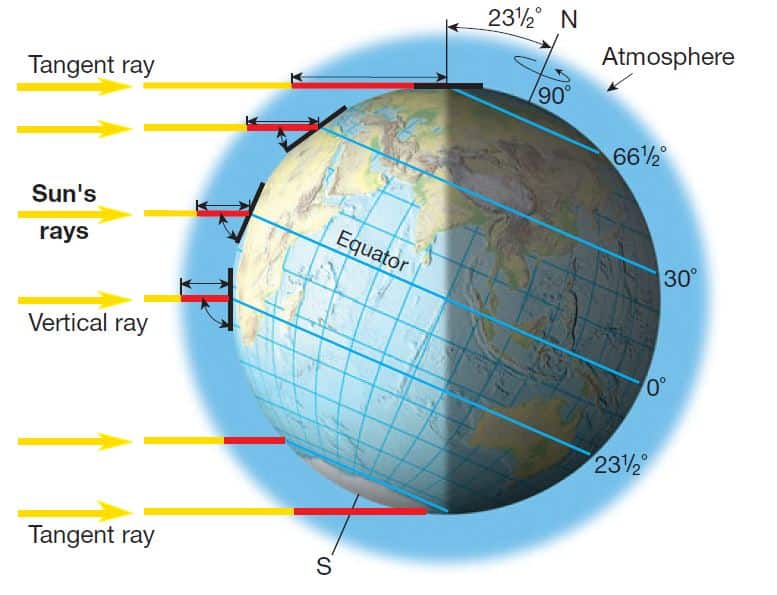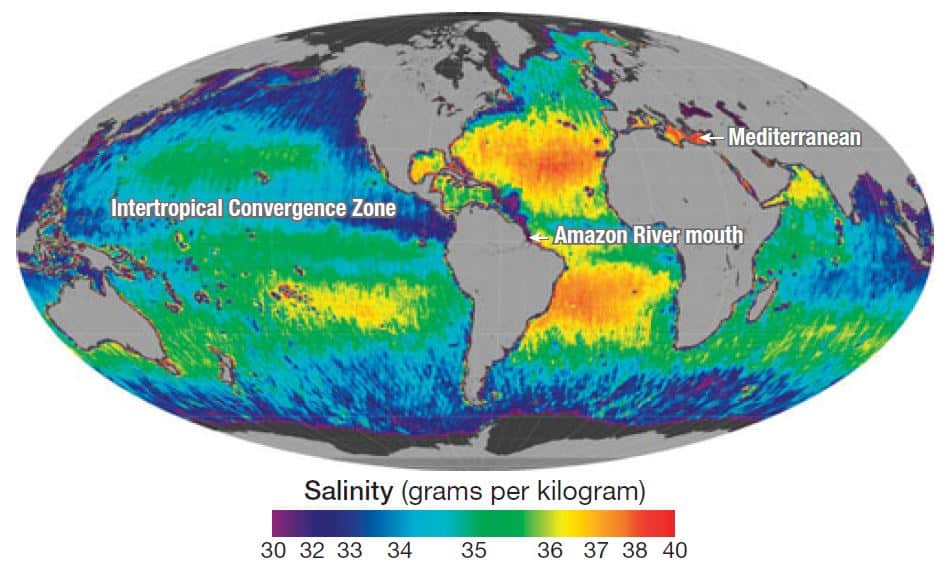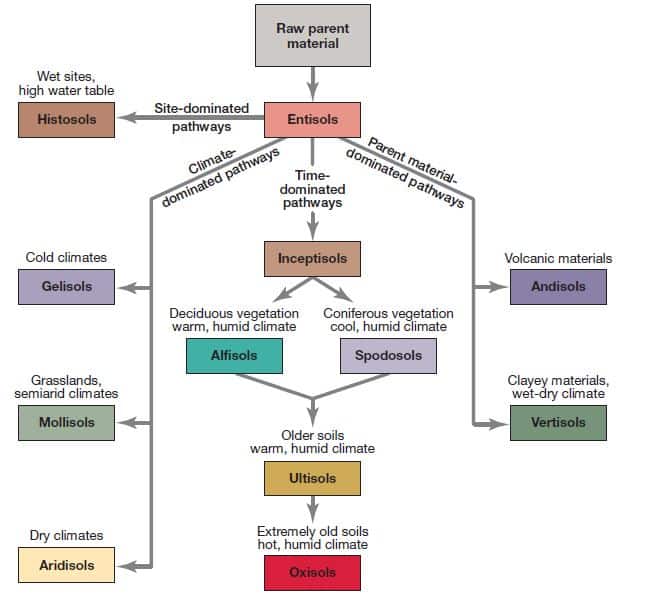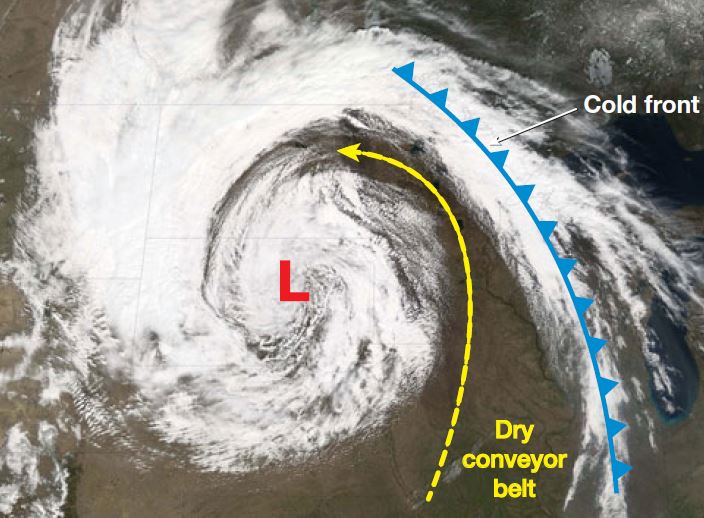Table of Contents
Heat budget of the earth and Distribution of Temperature | UPSC – IAS
Earth’s internal heat budget is fundamental to the thermal history of the Earth. A heat budget is the perfect balance between incoming heat absorbed by earth and outgoing heat escaping it in the form of radiation.
Learning Objectives:-
- Difference between Shortwave and Longwave Radiation
- What happens to solar radiation when it enters Earth’s atmosphere?
- How is solar radiation received and distributed ?
- How does electromagnetic radiation warm the atmosphere?
We begin by discussing Earth’s solar radiation “budget”—the balance of incoming and outgoing radiation.
Shortwave versus Longwave Radiation | UPSC – IAS
- Solar radiation is almost completely in the form of visible light, ultraviolet and short infrared radiation, which as a group is referred to as shortwave radiation.
- Radiation emitted by Earth -or terrestrial radiation – is entirely in the thermal infrared portion of the spectrum and is referred to as longwave radiation.
A wavelength of about 4 micrometers is considered the boundary on the spectrum separating longwave radiation from shortwave radiation. Thus, all terrestrial radiation is longwave radiation, whereas virtually all solar radiation is shortwave radiation.
Long-Term Energy Balance | UPSC – IAS
In the long run, there is a balance between the total amount of energy received by Earth and its atmosphere as insolation on one hand, and the total amount of energy returned to space on the other. (Humans are likely altering the energy balance of the atmosphere through greenhouse gas emissions – for the purposes of understanding atmospheric warming processes, we will ignore that possibility for the moment.)
- Although there is an overall long-term balance between incoming and outgoing radiation, the details of the energy exchanges between Earth’s surface and atmosphere are important for understanding basic weather processes.
Earth’s Energy Budget | UPSC – IAS
The balance of incoming and outgoing heat on Earth is referred to as its heat budget. While Earth’s energy budget accounts for the balance between the energy Earth receives from the Sun, the energy Earth radiates back into outer space after having been distributed throughout the five components of Earth’s climate system and having thus powered the so-called Earth’s heat engine.
- The annual balance between incoming and outgoing radiation is the global energy budget, which can be illustrated by using 100 “units” of energy to represent total insolation (100 percent of insolation) received at the outer edge of the atmosphere and tracing its dispersal.
- Keep in mind that the values shown here are approximate annual averages for the entire globe and do not apply to any specific location.
Radiation Loss from Reflection | UPSC – IAS
- Most of the incoming solar radiation that arrives at the upper atmosphere does not warm it directly.
- About 31 units of total insolation are reflected (or scattered) back into space by the atmosphere and the surface.
- The albedo of Earth, therefore, is about 31 percent.
Direct Absorption of Solar Radiation | UPSC – IAS
- Only 24 units of incoming solar radiation warm the atmosphere directly.
- About 3 units of radiation (in the ultraviolet portion of the spectrum) are absorbed by ozone and so warm the ozone layer.
- Another 21 units are absorbed by gases and clouds as incoming radiation passes through the rest of the atmosphere.
Surface-to-Atmosphere Energy Transfer | UPSC – IAS
- About 45 units of insolation – nearly half of the total – simply transmit through the atmosphere to Earth’s surface where it is absorbed, warming the surface. The warmed surface of Earth then in turn transfers energy to the atmosphere above in a number of ways.
- About 4 units of energy are conducted from Earth’s surface back into the atmosphere, where it is dispersed by convection. Energy is also transferred from the surface to the atmosphere through the transport of latent heat in water vapor.
- About three-fourths of all sunshine falls on a water surface when it reaches Earth. Much of this energy is utilized in evaporating water from oceans, lakes, and other bodies of water.
- About 19 units of energy pass into the atmosphere as latent heat stored in water vapor, eventually released when condensation takes place.
- Greenhouse gases absorb large amounts of longwave radiation emitted by the surface, and in turn radiate much of this energy back to the surface where it may be absorbed – and then reemitted as longwave radiation again. Through the absorption of terrestrial radiation by greenhouse gases, the atmosphere receives a net gain of 14 units of energy.
- A portion of the longwave radiation emitted by Earth’s surface, however, is transmitted directly through the atmosphere without being absorbed by the greenhouse gases.
- Approximately 8 units of energy – in the form of longwave radiation with wavelengths between about 8 and 12 micrometers – transmit through what is called the atmospheric window, a range of wavelengths of infrared radiation that is not strongly absorbed by any atmospheric component. For the most part, then, the atmosphere is warmed indirectly by the Sun: the Sun warms the surface, and the surface, in turn, warms the air above.
Consequences of Indirect Warming of Atmosphere | UPSC – IAS
This complicated sequence of atmospheric warming has many ramifications. Because the atmosphere is warmed mostly from below rather than from above, the result is a troposphere in which cold air overlies warm air.
This “unstable” situation creates an environment of almost constant convective activity and vertical mixing. If the atmosphere were warmed directly by the Sun, resulting in warm air at the top of the atmosphere and cold air near Earth’s surface, the situation would be stable, essentially without vertical air movements. The result would be a troposphere that is largely motionless, apart from the effects of Earth’s rotation.
Variations in Insolation by Latitude and Season | UPSC – IAS
The energy budget we just discussed is broadly generalized. Many latitudinal and vertical imbalances are in this budget, and these are among the most fundamental causes of weather and climate variations.
- In essence, we can trace a causal continuum wherein insolation absorption differences lead to temperature differences that lead to air-density differences that lead to pressure differences that lead to wind differences that often lead to moisture differences.
- It has already been noted that world weather and climate differences are fundamentally caused by the unequal heating of Earth and its atmosphere. This unequal heating is the result of latitudinal and seasonal variations in insolation.
Latitudinal and Seasonal Differences | UPSC – IAS
- There are only a few basic reasons for the unequal warming of different latitudinal zones. These reasons include variations in the angle at which solar radiation strikes Earth, the influence of the atmosphere itself on the intensity of radiation transmitted to Earth’s surface, and seasonal variations in day length.
Angle of Incidence | UPSC – IAS
The angle at which rays from the Sun strike Earth’s surface is called the angle of incidence. This angle is measured from a line drawn tangent to the surface. By this definition,
- A ray striking Earth’s surface vertically, when the Sun is directly overhead, has an angle of incidence of 90°,
- A ray striking the surface when the Sun is lower in the sky has an angle of incidence smaller than 90°, and
- A ray striking Earth tangent to the surface (as at sunrise and sunset) has an angle of incidence of 0°.
Because Earth’s surface is curved and because the relationship between Earth and the Sun changes with the seasons, the angle of incidence for any given location on Earth also changes during the year.
The angle of incidence is the primary determinant of the intensity of solar radiation received at any spot on Earth.
- If a ray strikes Earth’s surface vertically, the energy is concentrated in a small area;
- if the ray strikes Earth obliquely, the energy is spread out over a larger portion of the surface.
- The more nearly perpendicular the ray (in other words, the closer to 90° the angle of incidence), the smaller the surface area warmed by a given amount of insolation and the more effective the heating.
- Averaged over the year as a whole, the insolation received by high-latitude regions is much less intense than that received by tropical areas.
Atmospheric Obstruction | UPSC – IAS
Insolation does not travel through the atmosphere unimpeded—it encounters various obstructions in the atmosphere.
- Clouds, particulate matter, and gas molecules in the atmosphere may absorb, reflect, or scatter incoming solar radiation.
- The result of these obstructions is a reduction in the intensity of this energy by the time it reaches Earth’s surface. On average, sunlight received at Earth’s surface is only about half as strong as it is at the top of Earth’s atmosphere.
The attenuation (weakening) of radiation that passes through the atmosphere varies from time to time and from place to place depending on two factors:-
- The amount of atmosphere through which the radiation has to pass and
- The Transparency of the air.
The distance a ray of sunlight travels through the atmosphere (commonly referred to as path length) is determined by the angle of incidence. A high angle ray traverses a shorter course through the atmosphere than a low-angle one. A tangent ray (one having an incidence angle of 0°) must pass through nearly 20 times as much atmosphere as a vertical ray (one striking Earth at an angle of 90°).
The effect of atmospheric obstruction tends to reinforce the pattern of solar energy distribution at Earth’s surface established by the angle of incidence.
For example, in high latitudes the Sun has a lower angle of incidence and a greater path length through the atmosphere than in the tropics. Thus, there are smaller losses of energy in the tropical atmosphere than in the polar atmosphere.
Duration of sunlight | UPSC – IAS
The duration of sunlight is another important factor in explaining latitudinal inequalities in warming. Longer days allow more insolation to be received and thus more solar energy to be absorbed.
- In tropical regions, this factor is relatively unimportant because the number of hours between sunrise and sunset does not vary significantly from one month to another;
- At the equator, of course, daylight and darkness are equal in length (12 hours each) every day of the year.
- In middle and high latitudes, however, there are pronounced seasonal variations in day length. The conspicuous buildup of warmth in summer in these regions is largely a consequence of the long hours of daylight, and the winter cold is a manifestation of limited insolation being received because of the short days.
Latitudinal Radiation Balance | UPSC – IAS
As the vertical rays of the Sun shift northward and southward across the equator during the course of the year, the belt of maximum solar energy swings back and forth through the tropics.
- Thus, in the low latitudes, between about 38° N and 38° S, there is an energy surplus, with more incoming than outgoing radiation.
- In the latitudes north and south of these two parallels, there is an energy deficit, with more radiant loss than gain.
- The surplus of energy in low latitudes is directly related to the consistently high angle of incidence, and the energy deficit in high latitudes is associated with low angles.


